2016 DODGE GRAND CARAVAN coolant level
[x] Cancel search: coolant levelPage 315 of 707
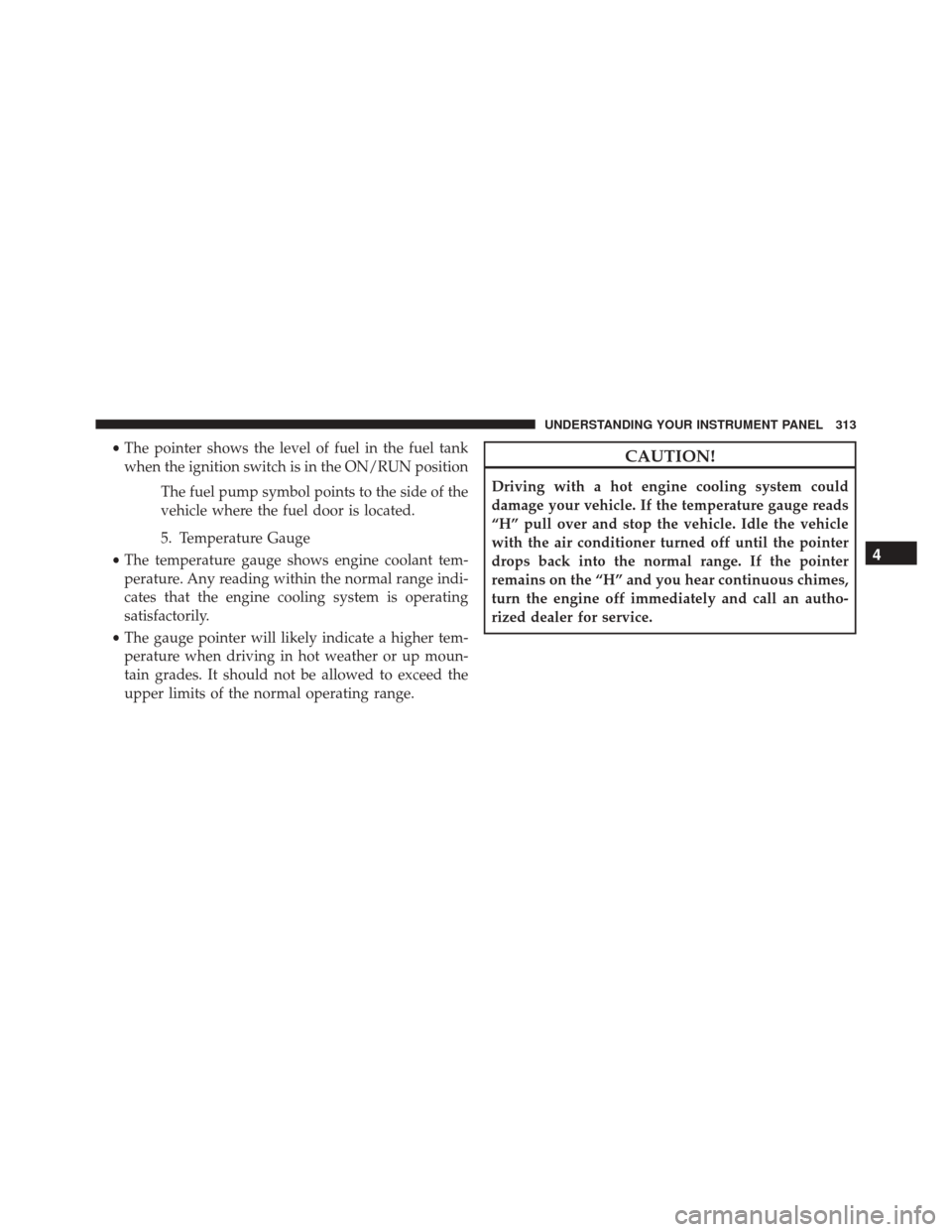
•The pointer shows the level of fuel in the fuel tank
when the ignition switch is in the ON/RUN position
The fuel pump symbol points to the side of the
vehicle where the fuel door is located.
5. Temperature Gauge
• The temperature gauge shows engine coolant tem-
perature. Any reading within the normal range indi-
cates that the engine cooling system is operating
satisfactorily.
• The gauge pointer will likely indicate a higher tem-
perature when driving in hot weather or up moun-
tain grades. It should not be allowed to exceed the
upper limits of the normal operating range.CAUTION!
Driving with a hot engine cooling system could
damage your vehicle. If the temperature gauge reads
“H” pull over and stop the vehicle. Idle the vehicle
with the air conditioner turned off until the pointer
drops back into the normal range. If the pointer
remains on the “H” and you hear continuous chimes,
turn the engine off immediately and call an autho-
rized dealer for service.
4
UNDERSTANDING YOUR INSTRUMENT PANEL 313
Page 460 of 707
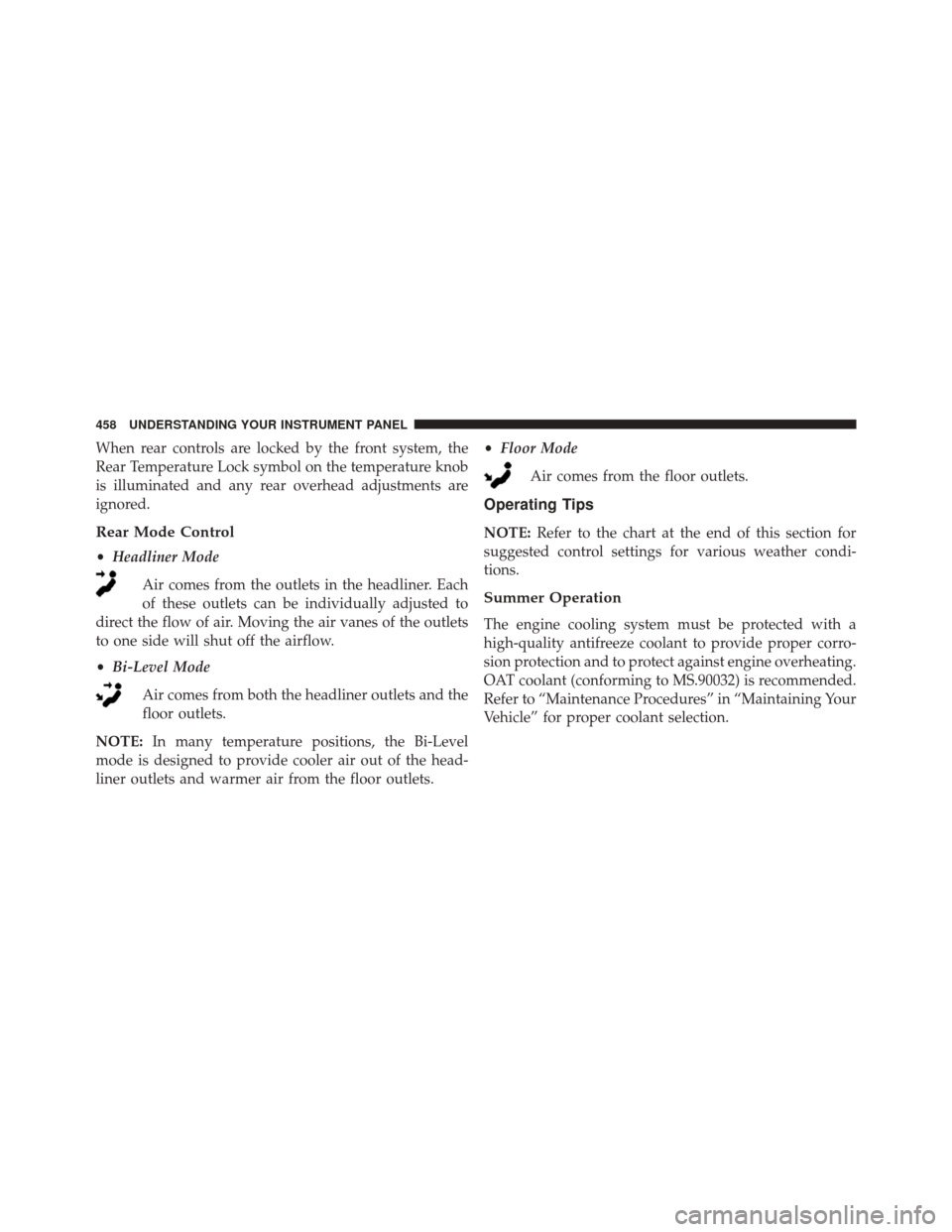
When rear controls are locked by the front system, the
Rear Temperature Lock symbol on the temperature knob
is illuminated and any rear overhead adjustments are
ignored.
Rear Mode Control
•Headliner Mode
Air comes from the outlets in the headliner. Each
of these outlets can be individually adjusted to
direct the flow of air. Moving the air vanes of the outlets
to one side will shut off the airflow.
• Bi-Level Mode
Air comes from both the headliner outlets and the
floor outlets.
NOTE: In many temperature positions, the Bi-Level
mode is designed to provide cooler air out of the head-
liner outlets and warmer air from the floor outlets. •
Floor Mode
Air comes from the floor outlets.
Operating Tips
NOTE: Refer to the chart at the end of this section for
suggested control settings for various weather condi-
tions.
Summer Operation
The engine cooling system must be protected with a
high-quality antifreeze coolant to provide proper corro-
sion protection and to protect against engine overheating.
OAT coolant (conforming to MS.90032) is recommended.
Refer to “Maintenance Procedures” in “Maintaining Your
Vehicle” for proper coolant selection.
458 UNDERSTANDING YOUR INSTRUMENT PANEL
Page 634 of 707
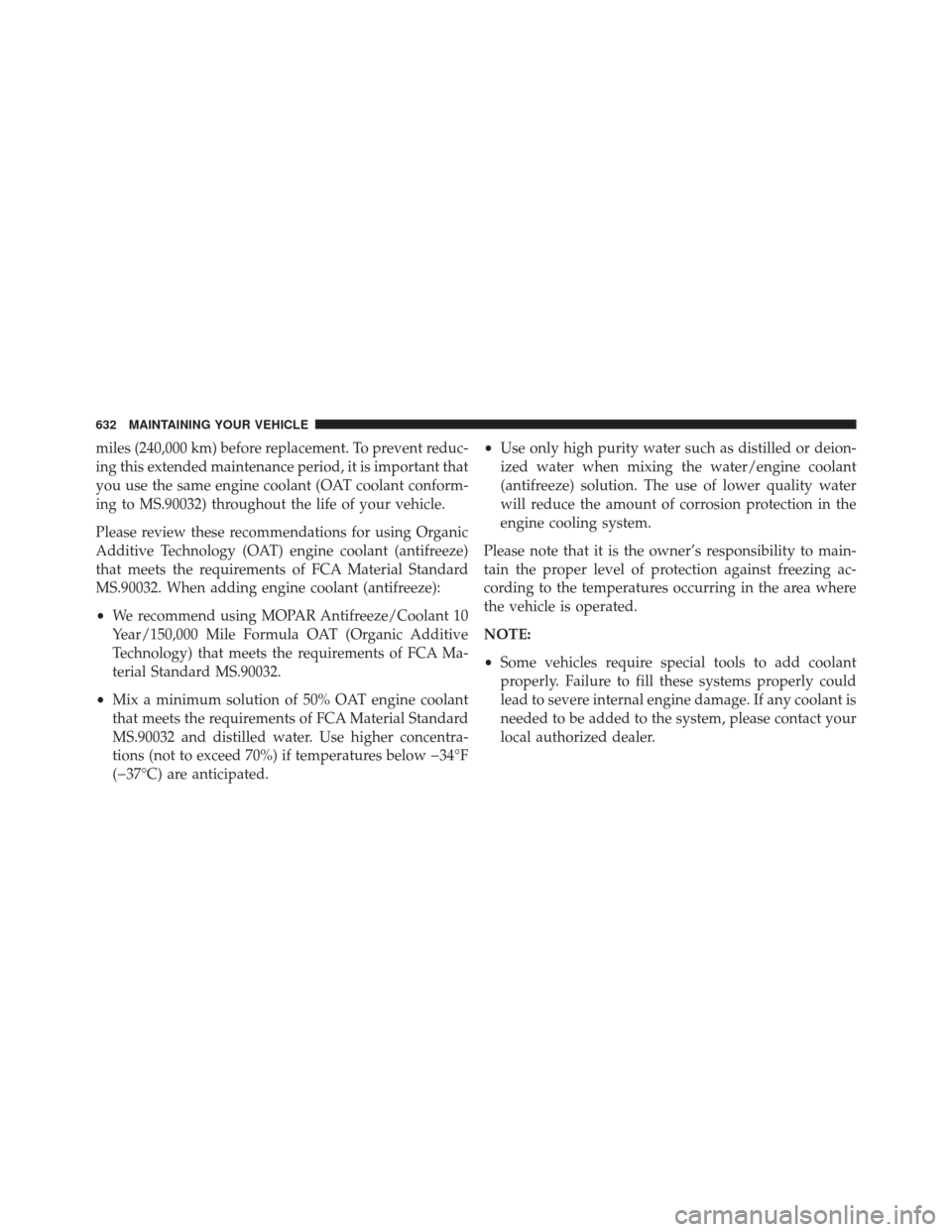
miles (240,000 km) before replacement. To prevent reduc-
ing this extended maintenance period, it is important that
you use the same engine coolant (OAT coolant conform-
ing to MS.90032) throughout the life of your vehicle.
Please review these recommendations for using Organic
Additive Technology (OAT) engine coolant (antifreeze)
that meets the requirements of FCA Material Standard
MS.90032. When adding engine coolant (antifreeze):
•We recommend using MOPAR Antifreeze/Coolant 10
Year/150,000 Mile Formula OAT (Organic Additive
Technology) that meets the requirements of FCA Ma-
terial Standard MS.90032.
• Mix a minimum solution of 50% OAT engine coolant
that meets the requirements of FCA Material Standard
MS.90032 and distilled water. Use higher concentra-
tions (not to exceed 70%) if temperatures below �34°F
(�37°C) are anticipated. •
Use only high purity water such as distilled or deion-
ized water when mixing the water/engine coolant
(antifreeze) solution. The use of lower quality water
will reduce the amount of corrosion protection in the
engine cooling system.
Please note that it is the owner’s responsibility to main-
tain the proper level of protection against freezing ac-
cording to the temperatures occurring in the area where
the vehicle is operated.
NOTE:
• Some vehicles require special tools to add coolant
properly. Failure to fill these systems properly could
lead to severe internal engine damage. If any coolant is
needed to be added to the system, please contact your
local authorized dealer.
632 MAINTAINING YOUR VEHICLE
Page 636 of 707
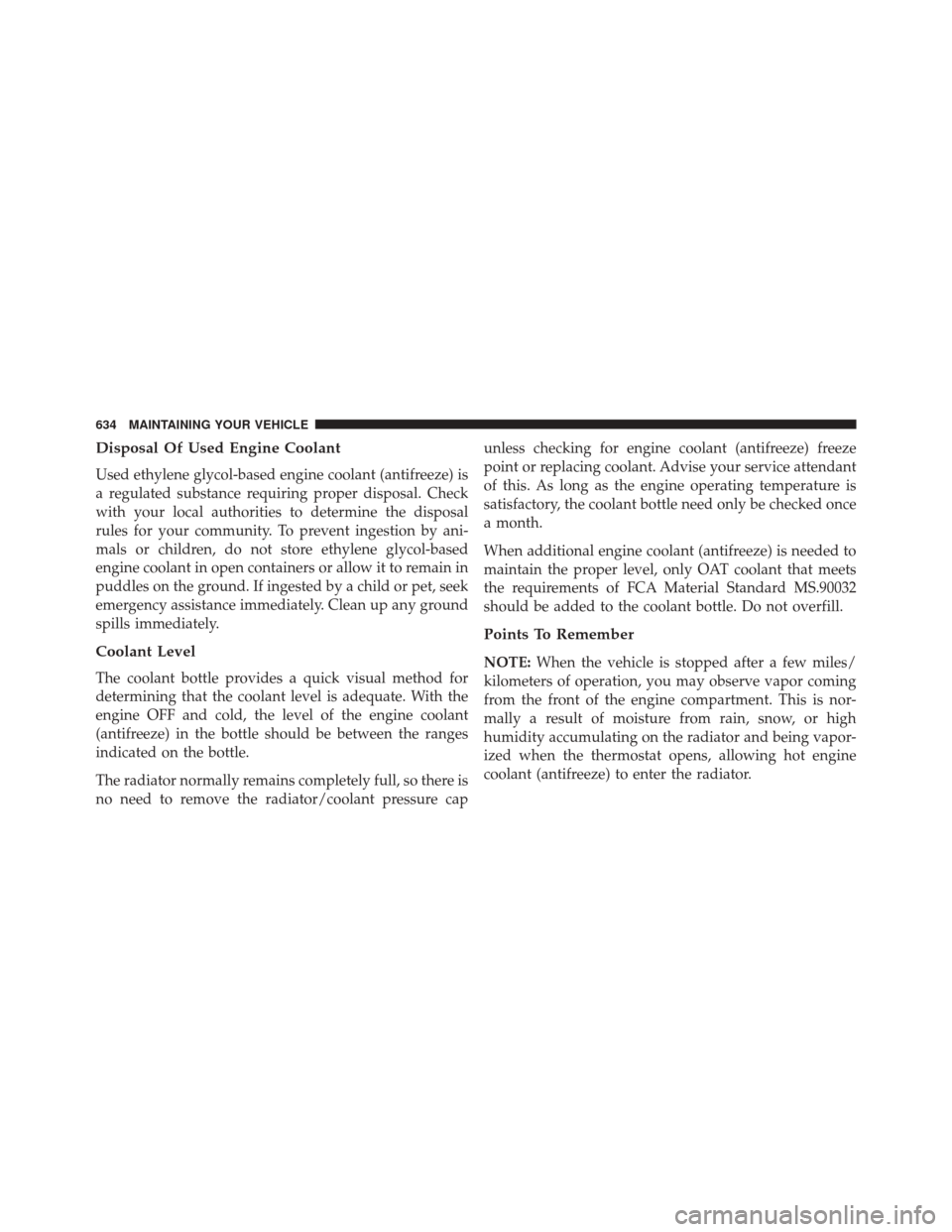
Disposal Of Used Engine Coolant
Used ethylene glycol-based engine coolant (antifreeze) is
a regulated substance requiring proper disposal. Check
with your local authorities to determine the disposal
rules for your community. To prevent ingestion by ani-
mals or children, do not store ethylene glycol-based
engine coolant in open containers or allow it to remain in
puddles on the ground. If ingested by a child or pet, seek
emergency assistance immediately. Clean up any ground
spills immediately.
Coolant Level
The coolant bottle provides a quick visual method for
determining that the coolant level is adequate. With the
engine OFF and cold, the level of the engine coolant
(antifreeze) in the bottle should be between the ranges
indicated on the bottle.
The radiator normally remains completely full, so there is
no need to remove the radiator/coolant pressure capunless checking for engine coolant (antifreeze) freeze
point or replacing coolant. Advise your service attendant
of this. As long as the engine operating temperature is
satisfactory, the coolant bottle need only be checked once
a month.
When additional engine coolant (antifreeze) is needed to
maintain the proper level, only OAT coolant that meets
the requirements of FCA Material Standard MS.90032
should be added to the coolant bottle. Do not overfill.
Points To Remember
NOTE:
When the vehicle is stopped after a few miles/
kilometers of operation, you may observe vapor coming
from the front of the engine compartment. This is nor-
mally a result of moisture from rain, snow, or high
humidity accumulating on the radiator and being vapor-
ized when the thermostat opens, allowing hot engine
coolant (antifreeze) to enter the radiator.
634 MAINTAINING YOUR VEHICLE
Page 662 of 707
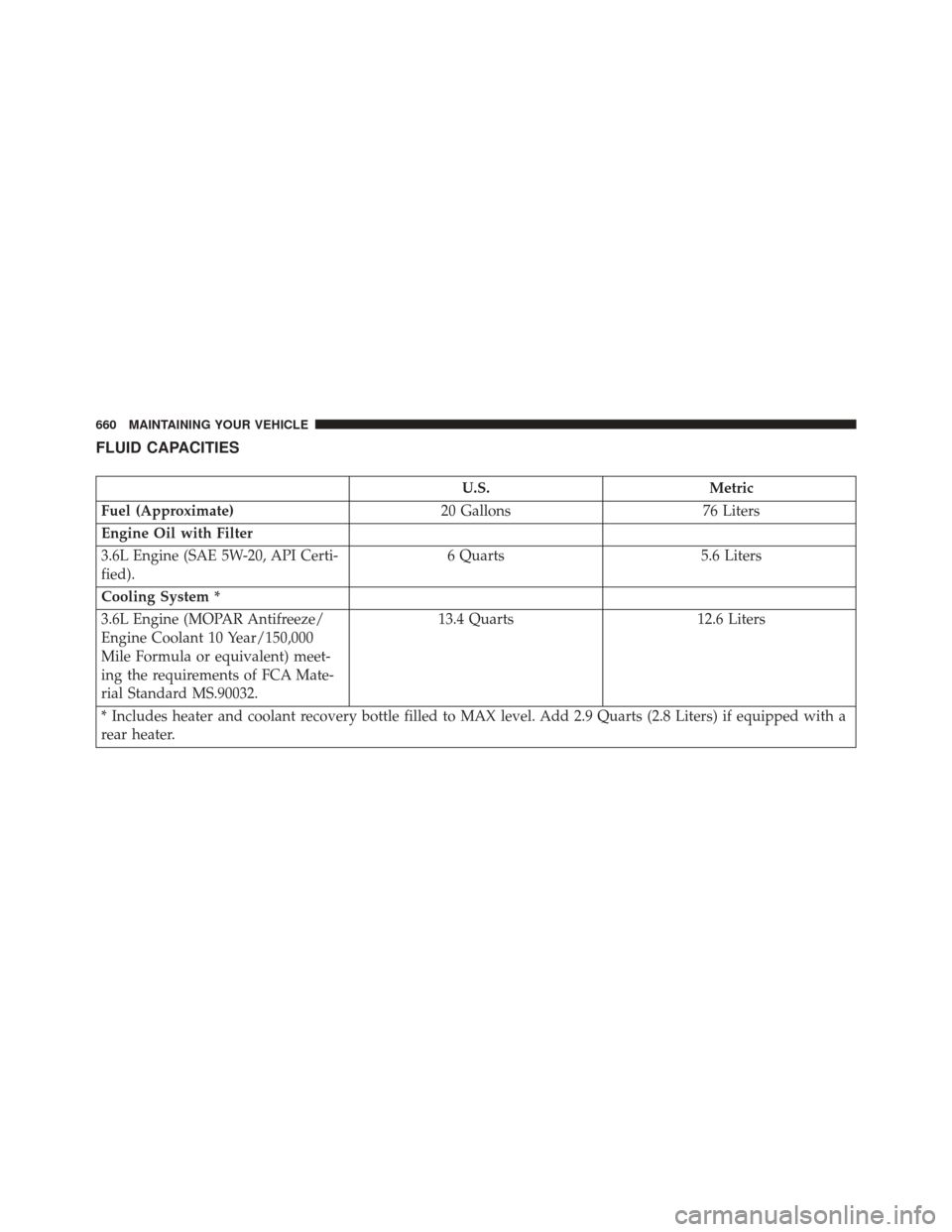
FLUID CAPACITIES
U.S.Metric
Fuel (Approximate) 20 Gallons76 Liters
Engine Oil with Filter
3.6L Engine (SAE 5W-20, API Certi-
fied). 6 Quarts
5.6 Liters
Cooling System *
3.6L Engine (MOPAR Antifreeze/
Engine Coolant 10 Year/150,000
Mile Formula or equivalent) meet-
ing the requirements of FCA Mate-
rial Standard MS.90032. 13.4 Quarts
12.6 Liters
* Includes heater and coolant recovery bottle filled to MAX level. Add 2.9 Quarts (2.8 Liters) if equipped with a
rear heater.
660 MAINTAINING YOUR VEHICLE
Page 669 of 707
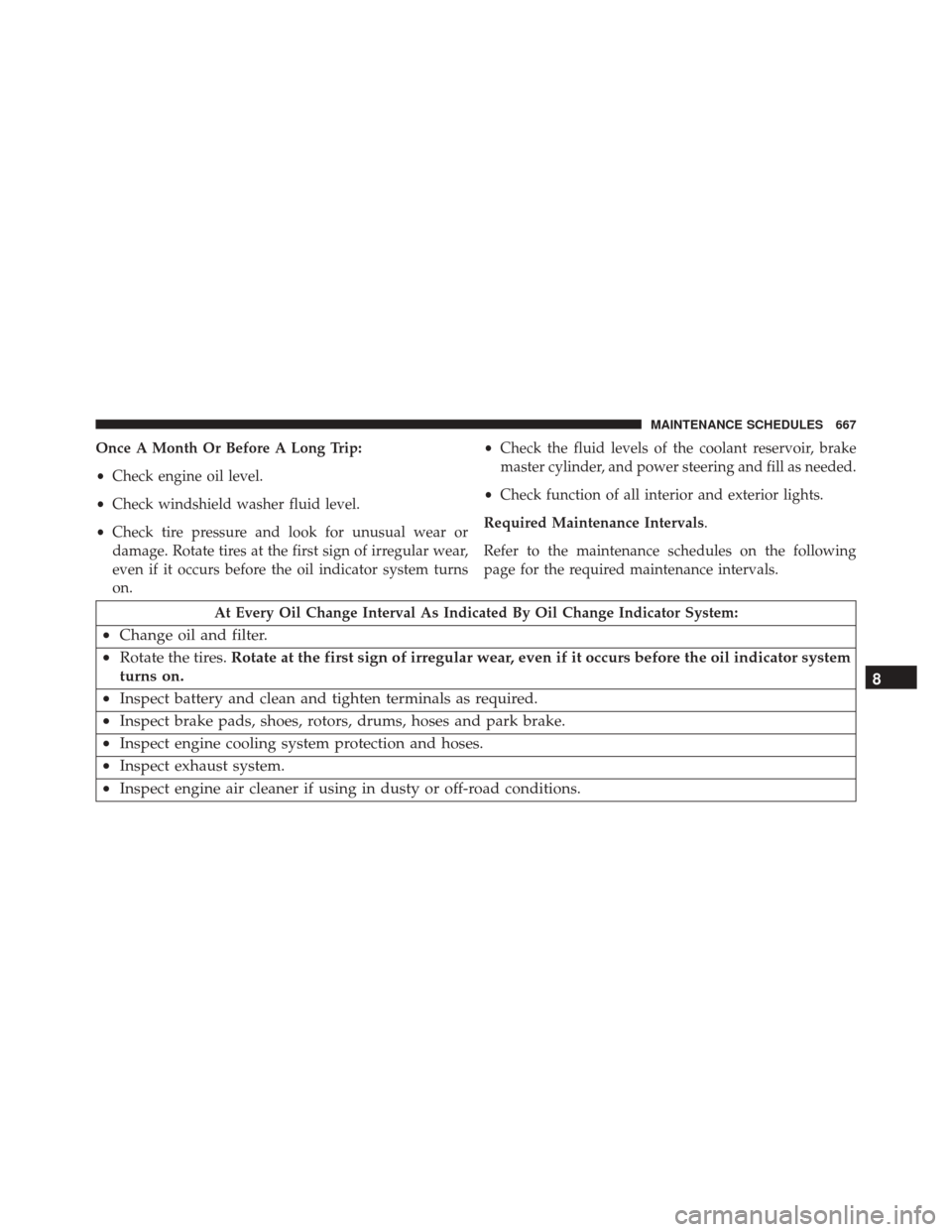
Once A Month Or Before A Long Trip:
•Check engine oil level.
• Check windshield washer fluid level.
• Check tire pressure and look for unusual wear or
damage. Rotate tires at the first sign of irregular wear,
even if it occurs before the oil indicator system turns
on. •
Check the fluid levels of the coolant reservoir, brake
master cylinder, and power steering and fill as needed.
• Check function of all interior and exterior lights.
Required Maintenance Intervals.
Refer to the maintenance schedules on the following
page for the required maintenance intervals.
At Every Oil Change Interval As Indicated By Oil Change Indicator System:
• Change oil and filter.
• Rotate the tires. Rotate at the first sign of irregular wear, even if it occurs before the oil indicator system
turns on.
• Inspect battery and clean and tighten terminals as required.
• Inspect brake pads, shoes, rotors, drums, hoses and park brake.
• Inspect engine cooling system protection and hoses.
• Inspect exhaust system.
• Inspect engine air cleaner if using in dusty or off-road conditions. 8
MAINTENANCE SCHEDULES 667
Page 689 of 707
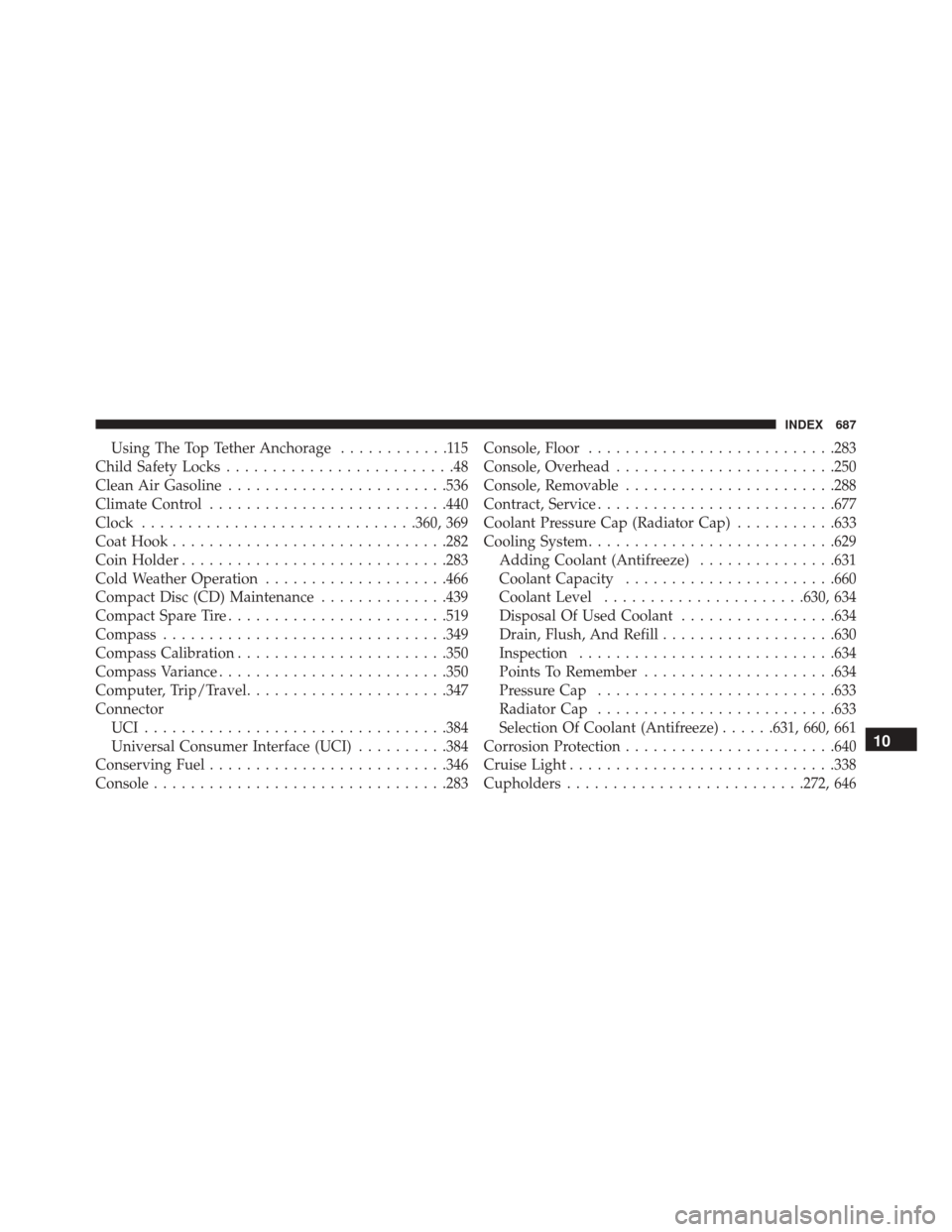
Using The Top Tether Anchorage............115
Child Safety Locks .........................48
Clean Air Gasoline ....................... .536
Climate Control ......................... .440
Clock ............................. .360, 369
Coat Hook ............................. .282
Coin Holder ............................ .283
Cold Weather Operation ....................466
Compact Disc (CD) Maintenance ..............439
Compact Spare Tire ....................... .519
Compass .............................. .349
Compass Calibration ...................... .350
Compass Variance ........................ .350
Computer, Trip/Travel ..................... .347
Connector UCI................................ .384
Universal Consumer Interface (UCI) ..........384
Conserving Fuel ......................... .346
Console ............................... .283Console, Floor
.......................... .283
Console, Overhead ....................... .250
Console, Removable ...................... .288
Contract, Service ......................... .677
Coolant Pressure Cap (Radiator Cap) ...........633
Cooling System .......................... .629
Adding Coolant (Antifreeze) ...............631
Coolant Capacity ...................... .660
Coolant Level ..................... .630, 634
Disposal Of Used Coolant .................634
Drain, Flush, And Refill ...................630
Inspection ........................... .634
Points To Remember .....................634
Pressure Cap ......................... .633
Radiator Cap ......................... .633
Selection Of Coolant (Antifreeze) ......631, 660, 661
Corrosion Protection ...................... .640
Cr
uise Light ............................ .338
Cupholders ......................... .272, 64610
INDEX 687
Page 691 of 707

Traction Control System...................495
Electronic Speed Control (Cruise Control) ........235
Electronic Stability Control (ESC) ..............495
Electronic Throttle Control Warning Light ........321
Electronic Vehicle Information Center (EVIC) ......339
Emergency, In Case Of Hazard Warning Flasher ..................567
Jacking .......................... .581, 589
Jump Starting ......................... .600
Overheating .......................... .567
Emission Control System Maintenance ..........615
Engine Air Cleaner .......................... .621
Block Heater ......................... .468
Break-In Recommendations ................118
Checking Oil Level ..................... .618
Compartment ......................... .613
Compartment Identification ................613
Coolant (Antifreeze) ..................630, 661 Cooling
............................. .629
Exhaust Gas Caution .................119,540
Flooded, Starting ...................... .466
Fuel Requirements ...................536, 660
Oil .......................... .618, 660, 661
Oil Filter ............................ .621
Oil Selection ...................... .619, 660
Oil Synthetic ......................... .620
Overheating .......................... .567
Starting ............................. .465
Engine Oil Viscosity ...................... .620
Engine Oil Viscosity Chart ...................620
Enhanced Accident Response Feature ............89
Entry System, Illuminated ....................19
Ethanol ............................ .537, 540
Event Data Recorder ........................92
Exhaust Gas Caution ....................119,540
Exhaust System .......................119,622
10
INDEX 689